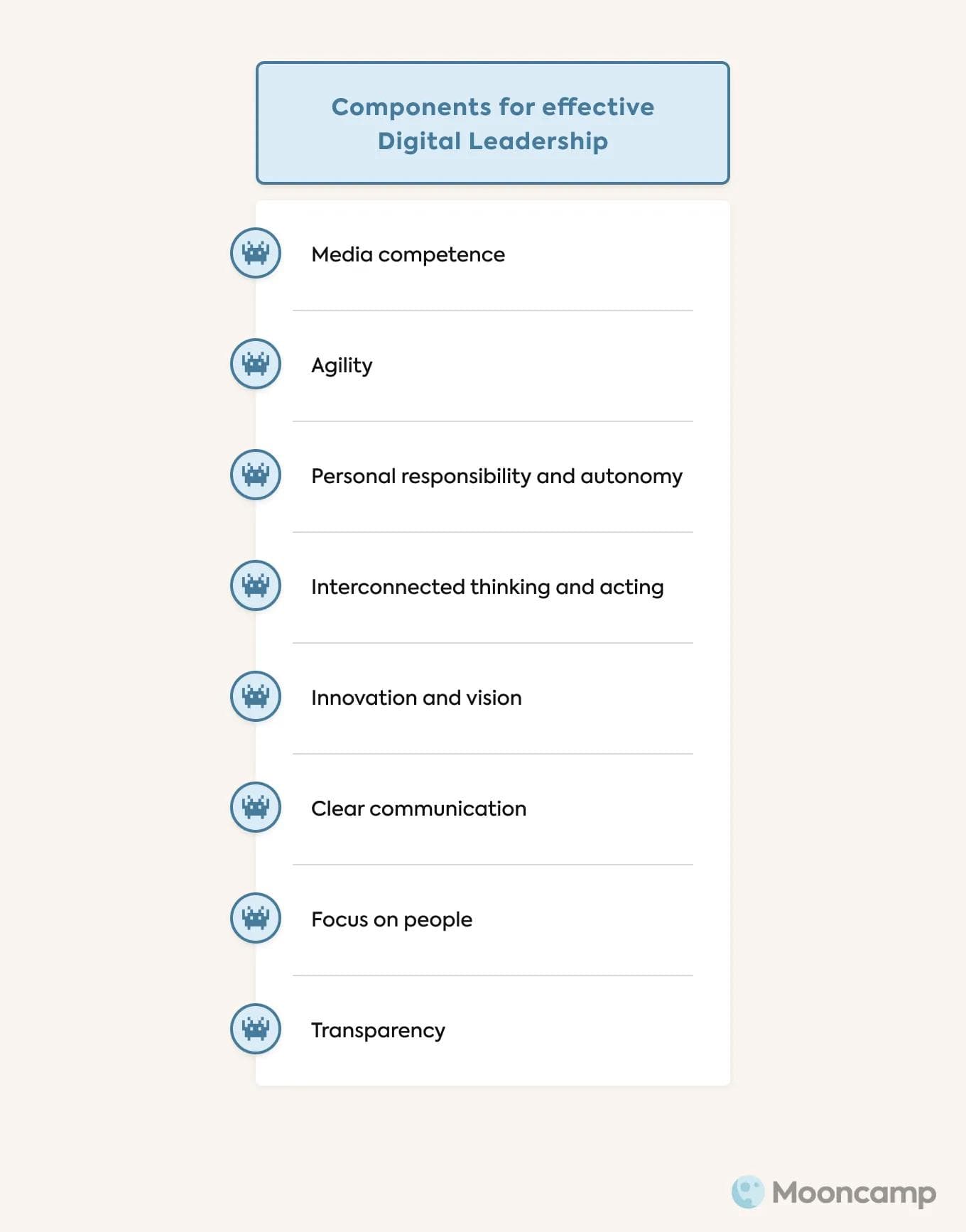Digital leadership: 8 components for being an effective digital leader

Digitalization stops at nothing and no one – not even top management. Nevertheless, digital leadership was hardly an issue in most companies until the Corona pandemic. Only since the majority of employees had to switch to home offices virtually overnight have many companies been rethinking their approach to leadership.
Digital leadership, however, doesn't just happen like that, it has to be learned. Simply knowing the current technologies and transferring traditional management tools one-to-one to the virtual space is not enough to meet the demands of modern everyday working life. Instead, you need a new way of working, tailored to digital transformation and true “digital leaders” who lead by example.
To help you make this transition, in this article we will clarify what digital leadership actually is, take a look at the specifics of digital teams, and show you what components are required for effective digital leadership.
What to expect:
- What is digital leadership?
- What challenges does digitalization imply?
- Special features of digital teams
- 8 components for successful leadership in digital times
- Conclusion: Digital leadership requires a new way of thinking
- Digital leadership – FAQ
What is digital leadership?
Digital leadership is more than just technical know-how and digital skills. Leading a team digitally means leading employees from a distance, i.e. without physical proximity, recognizing the opportunities of digitization and actively shaping the digital transformation in the company.
The term "digital leadership" therefore refers to a modern management style that focuses on initiating and supporting the digital transformation in a company. Successful “digital leaders” should be able to use digital tools sensibly and guide the company well through the digital age by making processes more agile, efficient and contemporary (keyword “new work”).
Which challenges does digitalization bring?
The digital age is characterized by constant, and at the same time rapid, change – also in the world of work. Processes are becoming increasingly automated and digitized, people are working independently of time and place, everyday working life is becoming more flexible thanks to remote offices and the like, and companies are increasingly globally connected.
In view of these changes, it is becoming increasingly important to act flexibly and think holistically. Accordingly, the demands on managers are more multi-layered, challenging and complex than ever before.
After all, good leadership in digital times means doing justice to the different interests of the company, the customers and the workforce in a fast-moving, dynamically changing working world. It also means managing change in a way that doesn't lose sight of future generations.
Special features of digital teams
Working in digital teams carries some special variables that any digital leader should be aware of and take into account:
- Little personal contact
- (Almost) no opportunities for spontaneous meetings
- Team members work in isolation
- Communication takes place predominantly virtually (e.g., via email, phone, video conferencing, Slack & Co.)
- Managers find it harder to assess employee performance
- Hardly any informal exchange of information
- More potential for misunderstandings
- Collaboration takes place regardless of time and place
- Different cultures meet
8 components for successful leadership in digital times
Communicating via email and Slack instead of picking up the phone or personally visiting employees at their desks does not constitute true digital leadership. Rather, leadership must change fundamentally to meet the demands of digitization.
We have compiled eight components of digital leadership here:
1. Media competence
Naturally, executives need an understanding of digital technologies as a basis for digital leadership. They have to be able to work with these themselves and to assess which emerging technology really advances the company – and which apps and applications are nice gimmicks but do not drive digital transformation or deliver any competitive advantage in the long term. In other words, an effective digital leader is technically savvy and knows digital programs and media so well they can use them optimally to achieve business goals.
2. Agility
Nowadays, the demands placed on companies change frequently and at high speed. Being able to react flexibly to these changes is essential to remain competitive. Complex tasks can no longer be planned in detail over the long term, especially when it comes to digital and IT-related projects. That's why digital leadership also means becoming more agile and rethinking workflows. True to the motto of Peter Drucker, the pioneer of modern management:
3. Personal responsibility and autonomy
Digital leadership means creating the framework for teams to work autonomously. An open culture of feedback, individual appreciation and plenty of room for maneuver ensure that employees are motivated to get to work and are willing to contribute to the company achieving its goals. Instead of just delegating and always having everything strictly under control, digital leaders should take on a coaching role, act as sparring partners for their workforce, and empower their team to achieve self-determined success. The bottom line is that most successful digital leaders trust in their team's abilities and merely set the direction or goals.
4. Interconnected thinking and acting
The complex demands of digital transformation cannot be managed in a linear fashion. Instead, digital leaders must link existing knowledge within their network in a meaningful way and bring employees together in interdisciplinary teams. After all, it is practically essential these days for people to work on projects across departments or companies.
5. Innovation and vision
Central to successful digital leadership are also a strong goal and a shared vision. Both must be clearly communicated so that everyone in the team understands what they are working toward. Good digital leaders take a courageous approach, develop innovative solutions and a vision together with their team, and strive to use creative approaches to solve tomorrow's problems today. Digital leadership therefore means leaving one's own comfort zone and always daring to try something new, e.g. launching new digital initiatives or revising business processes.
The following quote from George Westerman, lecturer at MIT's Sloan School of Management, sums it up well:
6. Clear communication
Communicating openly and clearly is one of the most important digital leadership skills. When teams work independently and from different locations, it is all the more crucial that there is plenty of communication. Expectations should be clearly stated, communication channels should be well-defined, and care should be taken to ensure that everyone has the information they need at all times. Opportunities for informal exchanges should also be part of the digital strategy and actively created by digital leaders.
💡 A recent study by the consulting agency McKinsey confirms: Clear communication, especially communicating a change story, is one of the most important competencies for digital leadership and successful digital transformation.
7. People in focus
Leadership today is increasingly about motivating, integrating, empowering and appreciating employees – and less about managing their day-to-day work. Employees, with their needs, potential, strengths and weaknesses, are the focus of digital leadership. A purely hierarchical leadership style is therefore less prominent in the context of digital leadership. A better approach would be to use digital business models that put the employee at the center and that are based on structural support and inspiration.
8. Transparency
Last but not least, digital leadership does not work without transparency – whether in terms of corporate values and goals or strategies for the future. Employees no longer just want to know what they have to do, but also why they should do it. Communicating this “purpose” transparently and providing all employees with the necessary information at all times is the main task of digital leaders.

Conclusion: Digital leadership requires a new way of thinking
Digitalization is bringing numerous changes to the working world, some of them profound. Managers should understand that the digital age is characterized by permanent and at the same time rapid change, to which they must respond flexibly. Purely hierarchical top-down leadership no longer has a place in our digital world.
Instead, successful digital leadership requires more open and agile leadership methods, such as Objectives and Key Results (OKRs), which place employees at the center and empower them. Successful digital leadership accordingly requires a fundamental shift in thinking – first and foremost in the minds of managers, but also in those of the workforce.
Digital leadership – FAQ
What is digital leadership?
Digital leadership is a modern leadership style with a clear focus on actively shaping the digital transformation within a company. The term summarizes tools and approaches that are essential for successfully leading companies in digital markets.
What makes a good digital leader?
The most important skills of digital leaders are interconnected thinking, employee orientation, appreciation, flexibility and agility, digital competence, clear communication and the ability to independently develop innovative ideas and work towards a shared vision.
What are examples of digital leadership tools?
Some of the most widely used tools for digital leadership include instant messaging services such as Slack, web-based project management software such as Trello or Asana, OKR tools such as Mooncamp for the management of objectives, video telephony platforms such as Microsoft Teams, and virtual collaboration applications such as SharePoint.
What makes digital leadership different?
In the digital age, executives increasingly need competencies such as communication skills, adaptability, appreciation, empathy, technical skills and innovative strength, among others.
